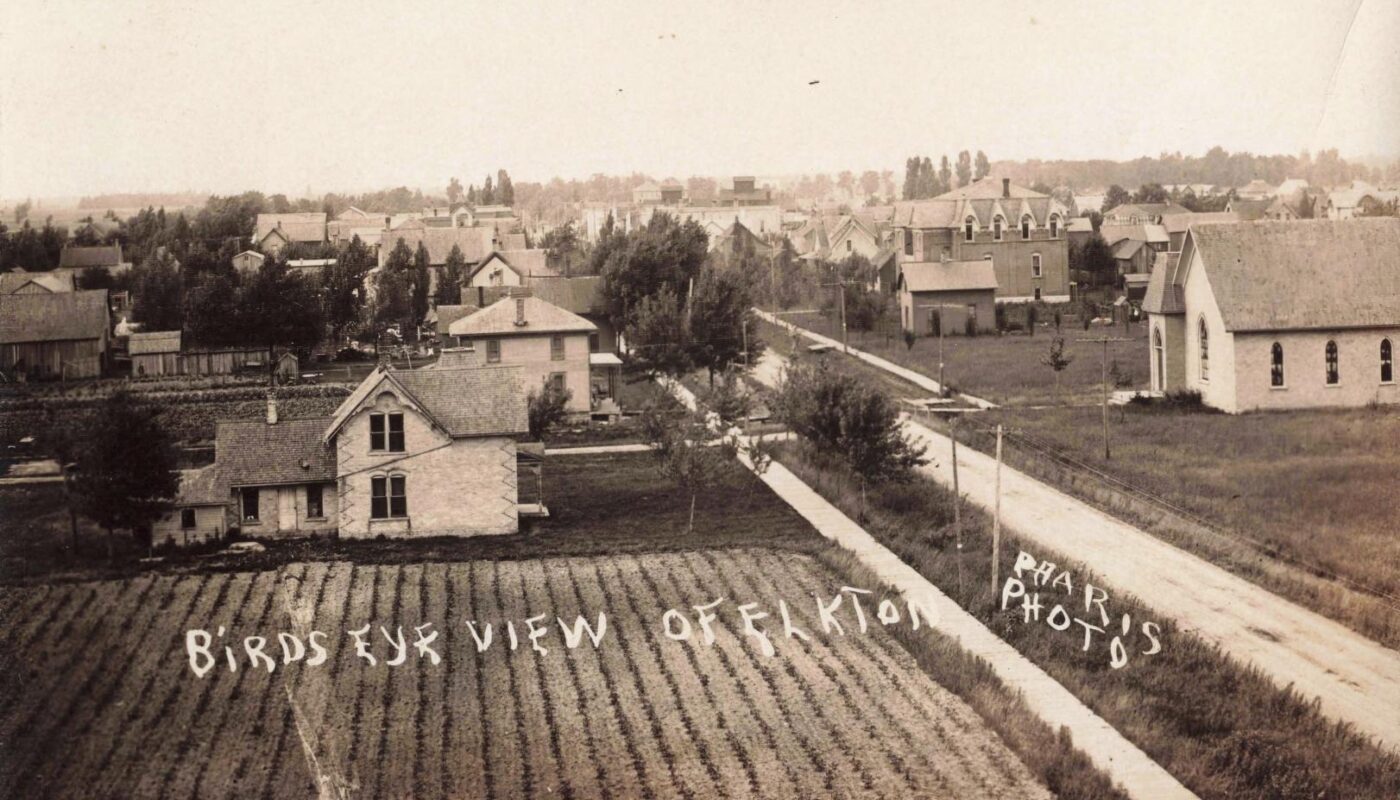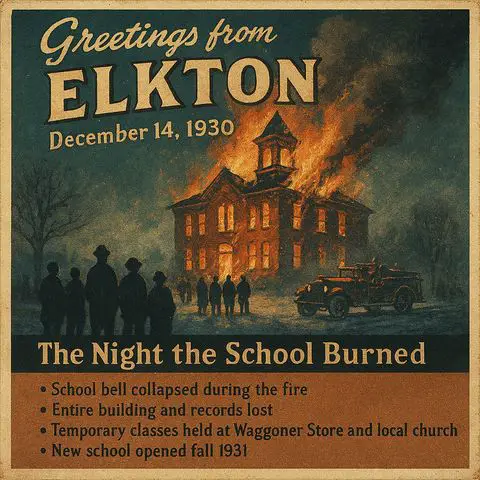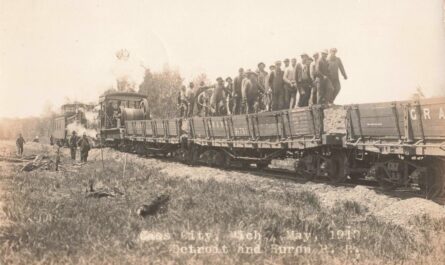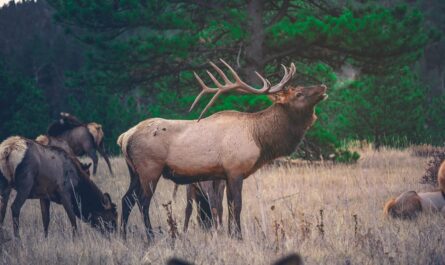We make a point of driving through Elkton every time we come up to the upper Thumb from downstate. Unlike many other small towns, it’s still very vibrant with business, and I like its colorful murals. (You have to go looking for them) We bought our refrigerator and stove from Thumb Hardware and had lunch at the Hitching Post after a round of golf at Century Oaks Golf Club. I’ve touched on topics about Elkton, but never did a deep dive into Elkton Michigan history until we discovered a cache of old photos from the Libraries at the University of Michigan. Here is what we found.
Elkton Michgian History
Where Elk and Iron Met: The Curious Origins of Elkton, Michigan
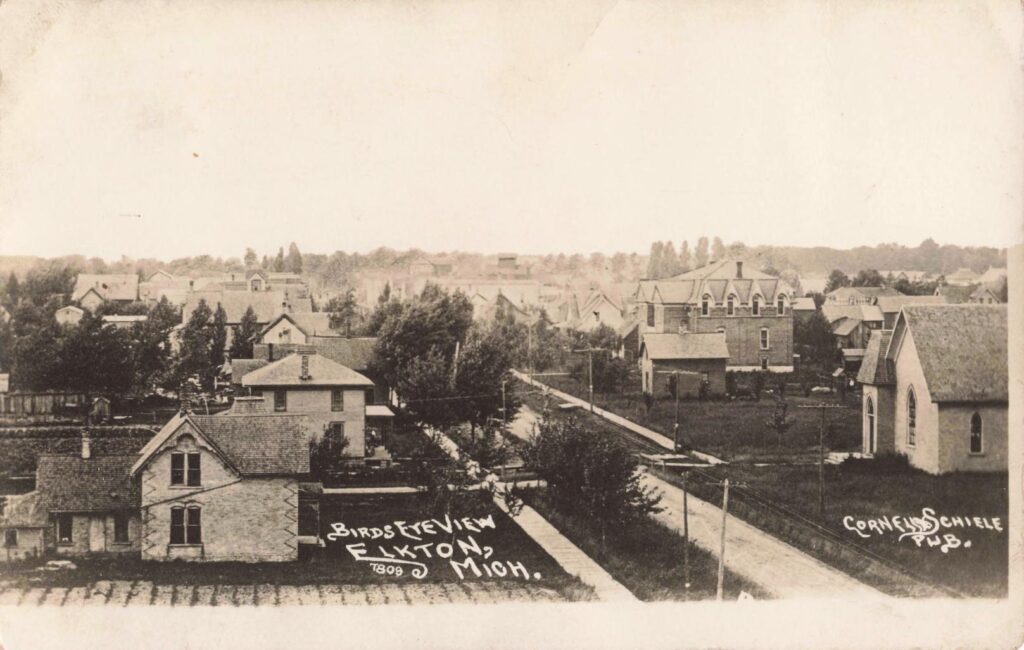
In the late 1800s, Elkton grew up as a frontier village in Michigan’s “Thumb” region. It was first settled around 1877 in Oliver Township and was initially called Oliver Center. In 1886, blacksmith W.J. McGillivray built the first house and named the town Elkton (reportedly after an elk he’d killed on his wife’s clothesline). That same year (Nov. 24, 1886), Simon Hoffman became Elkton’s first postmaster. The village was laid out along the new Saginaw, Tuscola & Huron Railroad line, which linked Thumb farms to big-city markets. (Railroad timetables later list Elkton as a Pere Marquette / C&O depot.) The railroad’s arrival drove Elkton’s economy, and the depot became a village landmark (see image below). In 1897, Elkton was formally incorporated as a village.
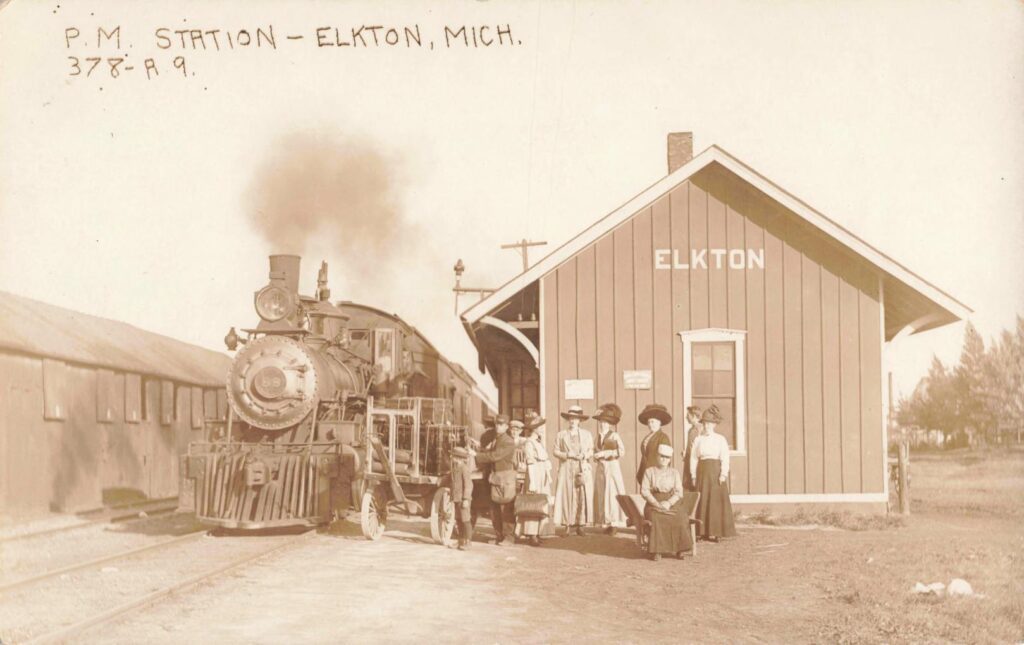
From Rails to Rows – How the Railroad and Farming Built Elkton’s Backbone
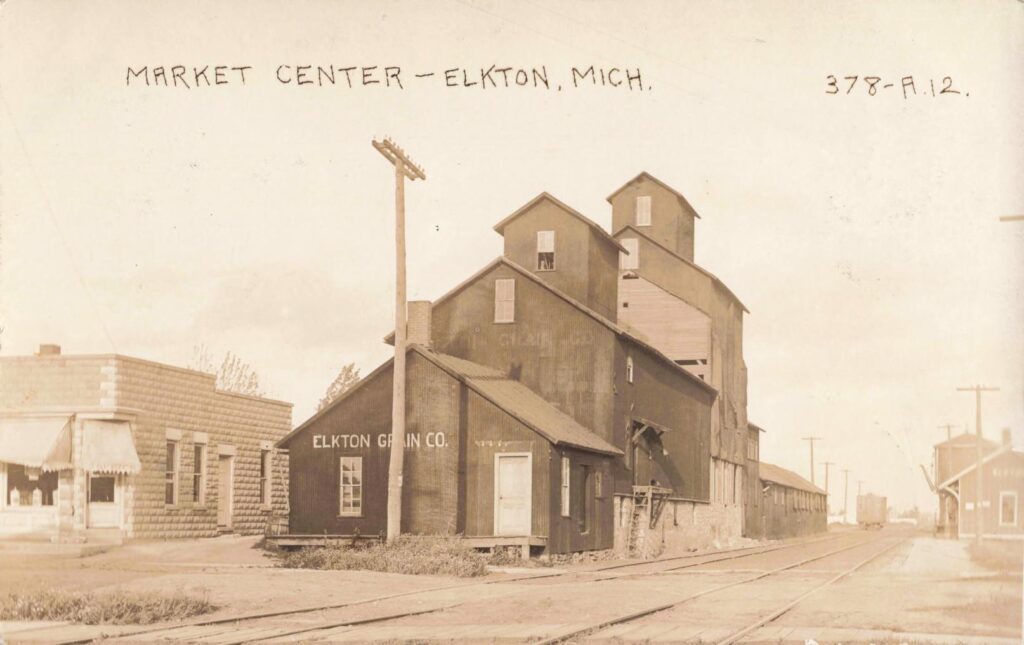
Elkton lies in one of Michigan’s richest farming counties. By the early 20th century, Huron County was known for grain, sugar beets, dairy, apples, and berries (the region’s light soil was ideal for such crops. Elkton’s farmers stored wheat and corn in local grain elevators that lined the railroad tracks. For example, the Elkton Grain Co. elevator (pictured above) handled thousands of bushels of grain each season. Local cooperatives later modernized these facilities (by the 1930s, the village even opened a gas station as farm tractors and cars arrived). A 1910s plan formed a farmers’ co-op to expand grain storage; over time Elkton’s elevators were upgraded to concrete silos with vast capacity (eventually part of the Cooperative Elevator Co.)
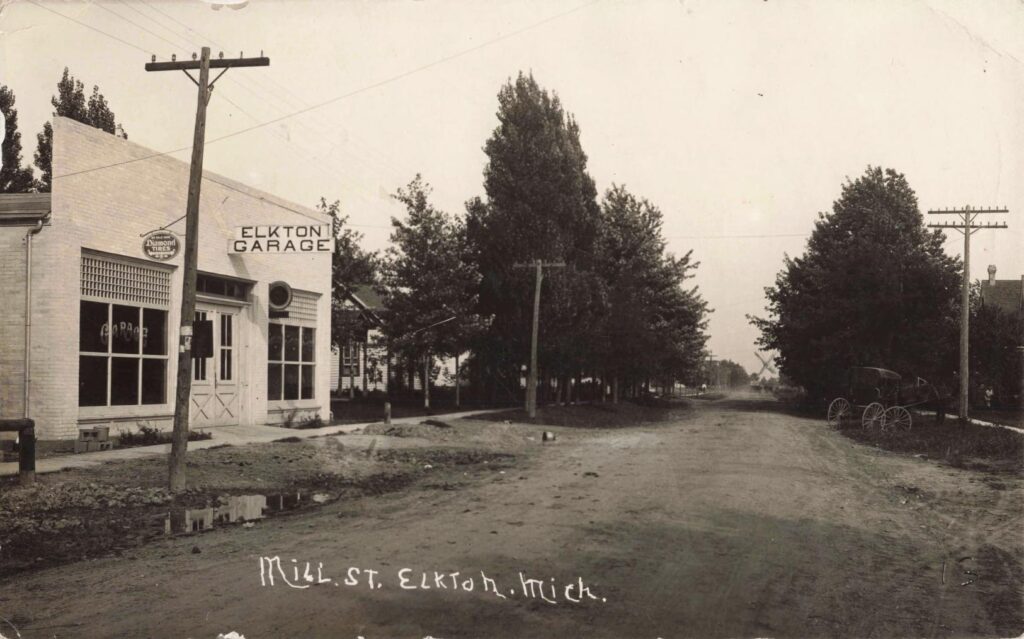
Meanwhile, roads and highways improved. By the 1910s, automobiles appeared on Elkton’s dirt Main Street (earlier horse-drawn wagons shared the road with the first cars). Local businesses adapted: Elkton’s first garage (“Elkton Garage”) sold tires and serviced autos.
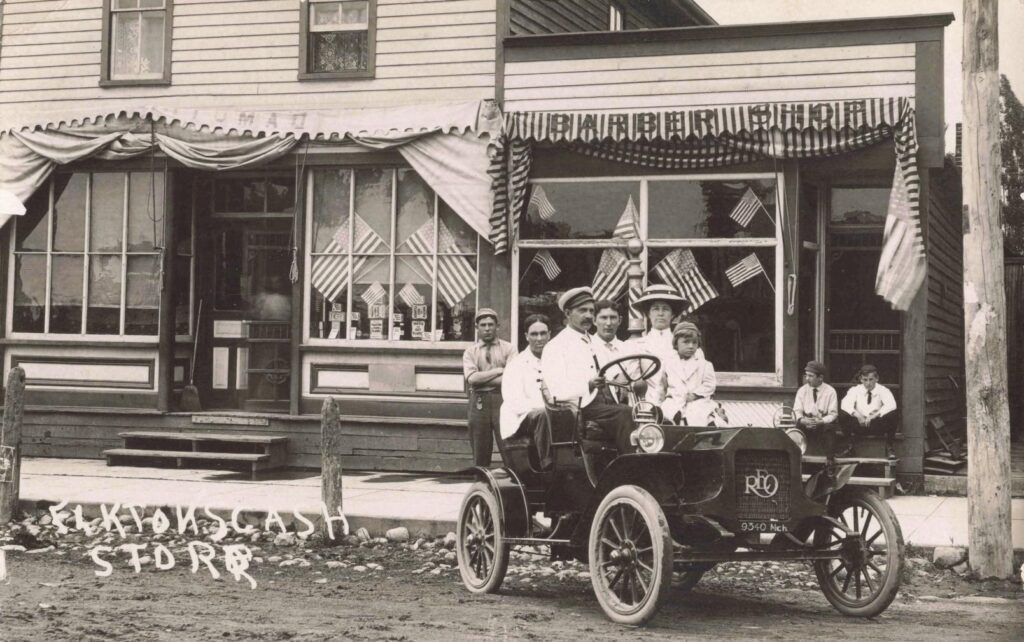
These changes punctuated daily life – men in bowler hats and women in early 20th-century dress stand by their new cars in front of the Elkton Cash Store (pictured) – yet farmers still drove horses to town on farm errands.
Awnings, Wagons, and Sunday Suits: Main Street in Full Swing
Elkton’s downtown was a classic small-town Michigan Main Street. Early postcards show wooden storefronts and sidewalks filled with carts and townsfolk (above). Notable businesses included general stores, a drugstore (“Cook’s” on one corner), a post office, and a butcher or grocery. By the 1910s, brick buildings replaced some frame stores. For example, the block on North Main Street housed dry goods, clothing shops, and a feed store (“Louis O. Dry Goods – Groceries”), advertising everything from shoes to rugs.
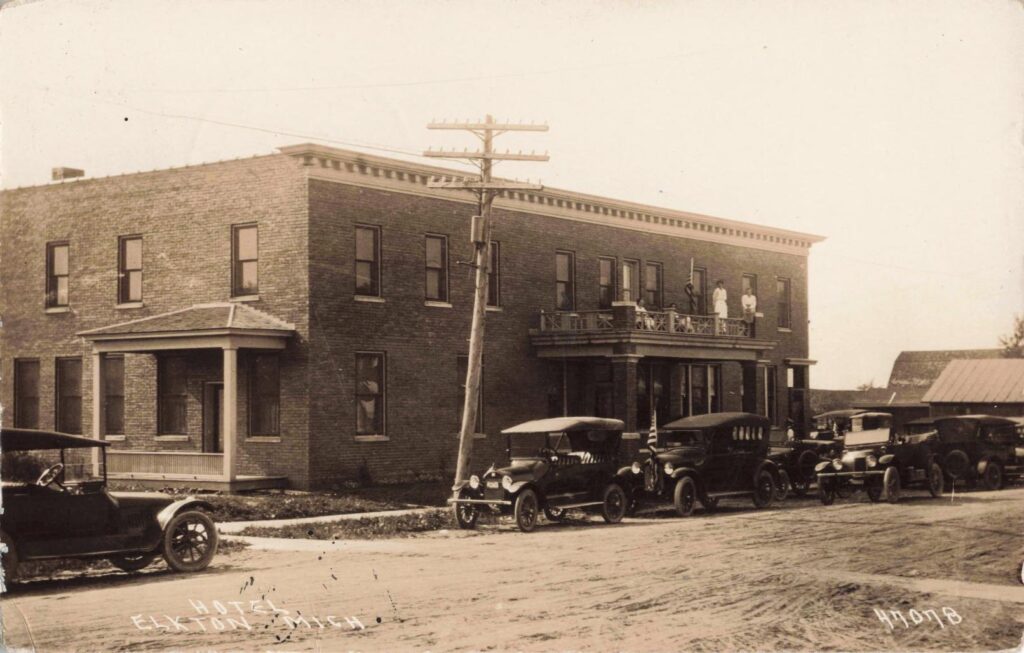
A 1909 Sanborn map even marks a modern new building called the “Hotel Huron” (later “Commercial House”) at the north end of town. This three-story brick Elkton Hotel was owned by local brewer Henry Gosen and financed by Saginaw’s Banner Brewing Co. Its twin saloon in Hemlock shows Elkton’s ties to regional entrepreneurs.
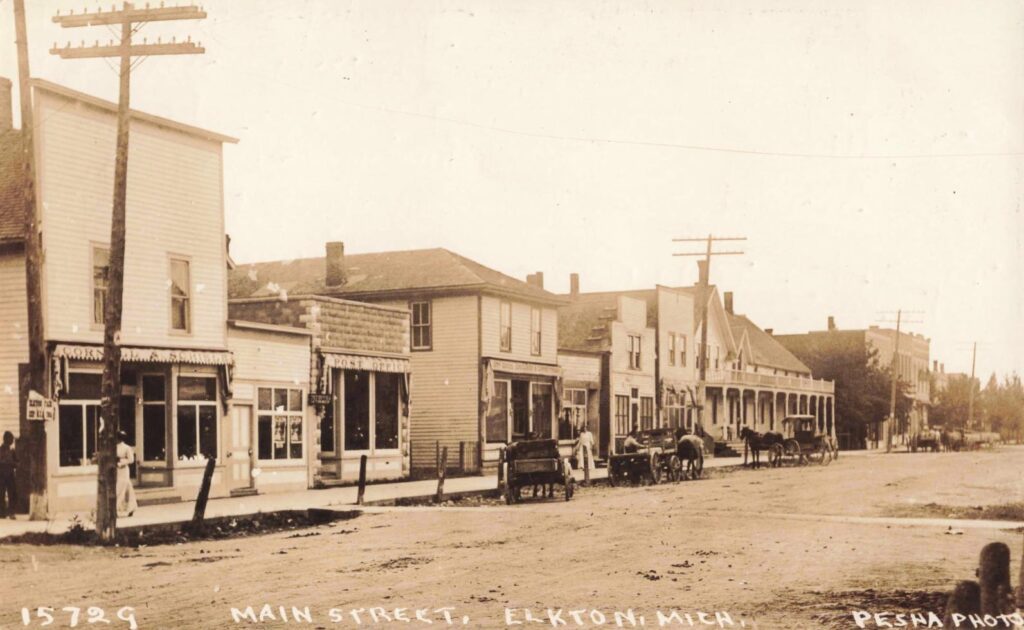
By the 1920s, many Elkton merchants sold gasoline and car services alongside groceries and clothing, reflecting the auto age. Sidewalk scenes show a growing line of early cars parked on Main Street (see image below). American flags on storefronts suggest parades and holidays were community highlights. Even advertising appears: a sign in one photo announces a “League Ball Today – Harbor Beach” baseball game, hinting that local teams drew crowds on weekends. Community life revolved around these Main Street shops, where farmers brought produce and townsfolk bought supplies.
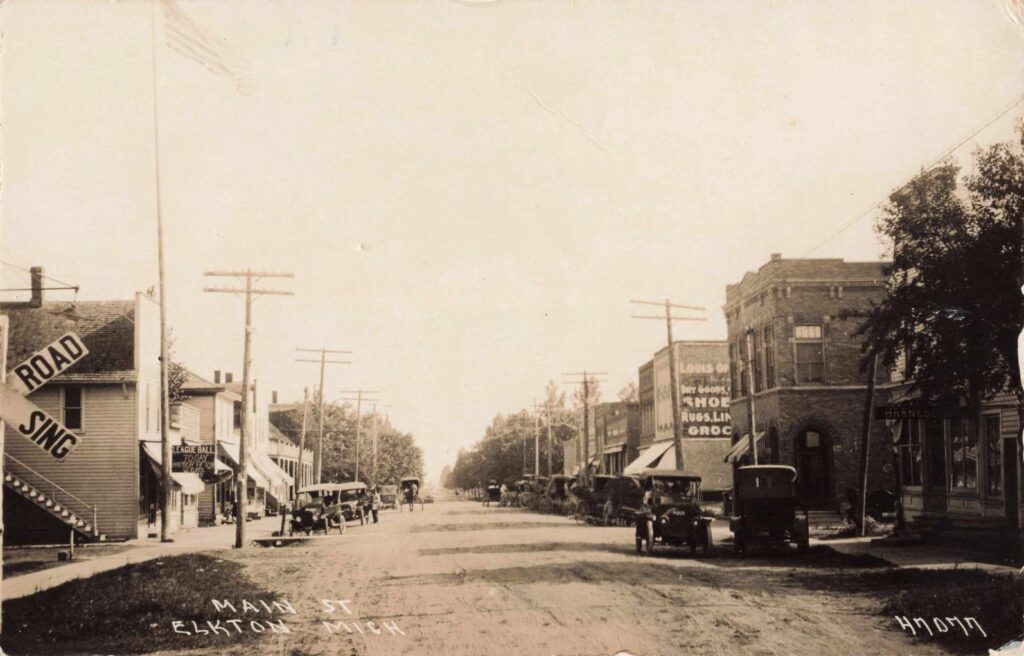
Opera Upstairs, Odd Fellows Below
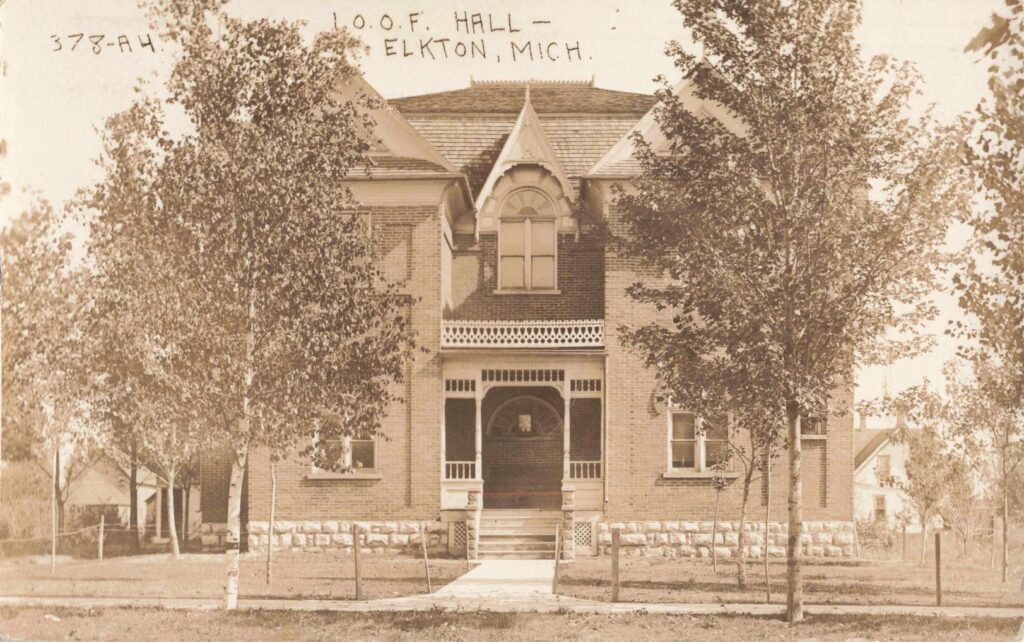
Elkton’s social life centered on community institutions. In 1908, the village boasted an I.O.O.F. Hall & Opera House (the Independent Order of Odd Fellows lodge). The wood-frame Opera House hosted concerts, plays, and even traveling vaudeville acts – a big draw when cities were hours away. Locals like Mrs. Cornell and Mr. Scherck ran the hall (their names are painted on the building in a 1908 photo). Grange meetings and church socials also used this hall, making it a cultural hub.
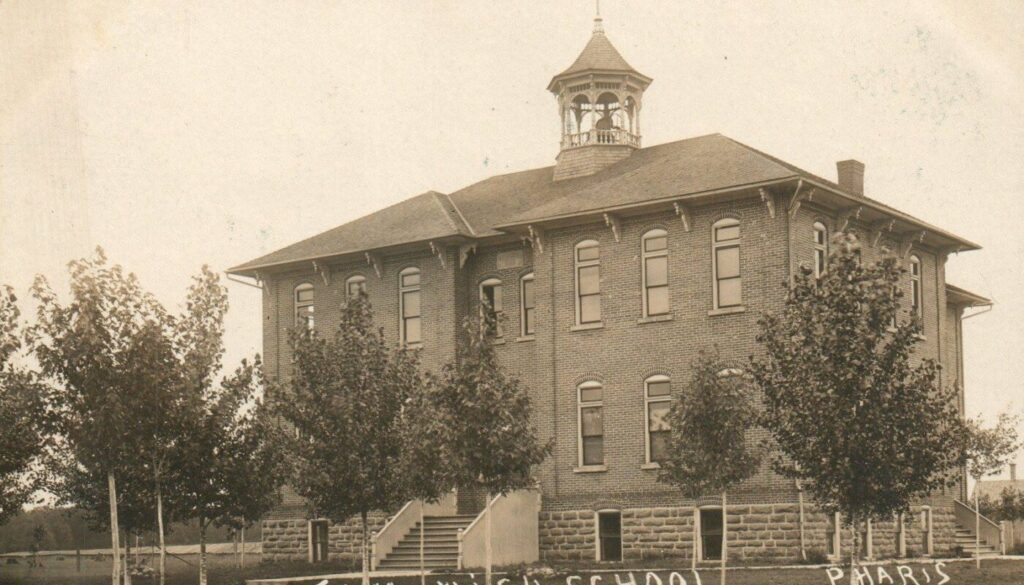
Children attended Elkton schools on Main Street. The first school opened in 1888 in a simple frame building (on the site of today’s water tower). As Elkton grew, a new red-brick school was built at the north end of town in 1902. By 1907, it had all 12 grades and a public library. Elkton’s school was well-regarded – it earned accreditation from the University of Michigan by 1925. Sports teams, band, and choir became popular: girls’ and boys’ glee clubs formed in 1928, and a 15-piece school band started that year (growing to 42 members by 1938).
Residents also gathered for dances, picnics, and holiday parades. Fourth of July celebrations featured flag-decorated storefronts and children’s contests. As the field sign shows, baseball was big – teams from neighboring towns like Harbor Beach played at Elkton. Many families belonged to the Lutheran, Methodist and Evangelical churches; community picnics and county fairs were annual traditions on nearby farms. In short, Elkton’s life was that of a typical Midwestern farming village: centered on school, church, and the slow-paced rhythms of rural Michigan.
The 1930 School Fire and Renewal
A dramatic turning point came on Dec. 14, 1930, when Elkton’s main school burned to the ground. An evening fire raced through the old wooden floors and walls; villagers heard the town siren and ran to help, but even a fire engine from neighboring Pigeon could not stop the blaze. They watched helplessly as the school bell crashed down and records went up in flames. By dawn, only ashes remained of the two-story brick school building. The loss was heartbreaking – every local child’s school days had been there.
Yet the community rallied. The school board (led by Dr. H.J. Fox and others) organized classes in temporary sites that winter. High schoolers met in the empty Waggoner Store on Main Street (formerly Bud’s Bar), and grade students met in the basement of the local Evangelical church. By March 1931, voters approved a $60,000 bond to rebuild on the same site. Construction proceeded quickly: the new gym/auditorium opened the following fall and hosted the 1931 graduation. By late 1931, a modern brick school stood in place of the old one – in its time, “one of the finest school buildings in Huron County”. (The school would serve the community until Elkton joined nearby Pigeon and Bay Port to form the Laker School District in 1961.)
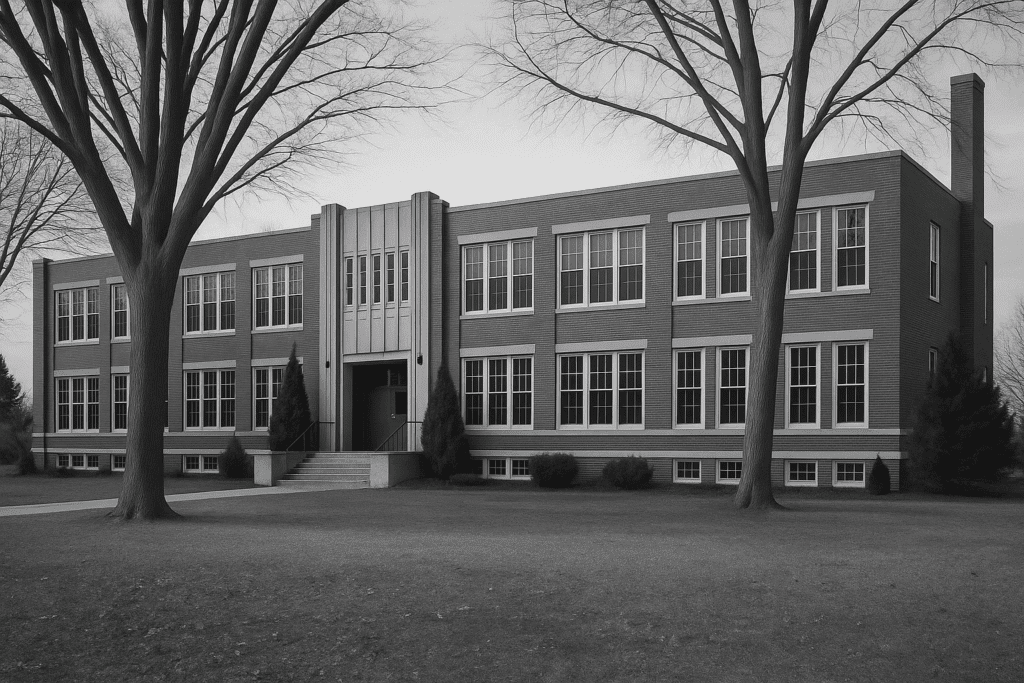
Despite the tragedy, the swift rebuilding showed Elkton’s resilience. The fire is still remembered in town lore – a story of loss, community spirit, and rebirth. (No definitive cause was ever reported in contemporary accounts.) The new school’s opening was a source of pride, symbolizing that Elkton’s children would continue to be educated in their home village for generations.
Notable Elkton Figures and Anecdotes of Elkton, Michigan History
- W.J. McGillivray, the village founder, is legendary as the blacksmith who named Elkton after that elk on the clothesline.
- Simon Hoffman, the first postmaster (1886), helped establish Elkton’s first U.S. Post Office.
- Henry Gosen ran the Elkton Hotel (also called “Commercial House”) after 1900. Local accounts say his hotel saloon was financed by Banner Brewing of Saginaw. (Elkton’s hotel was said to be a twin of one built simultaneously in Hemlock.)
- Kenneth Ginter (b.1890) set up Elkton Electric in 1930, selling radios and home appliances on Main Street. His store housed Elkton’s first television: neighbors gathered around the shop’s big TV (antenna mounted on a 70-foot tower) to watch Joe Louis fights and news – a novelty in the 1940s.
- Local press: The Elkton Times (first issue Nov. 29, 1883) was Elkton’s first newspaper. It became the Elkton Record in 1884 under C.A. Bancroft. (This village paper reported on every community event through World War II.)
- School leaders: After the fire, Superintendent Ivan Kurrle (hired in 1930) and Principal Earl Eidt made sure education continued despite the crisis. Notably, 1931 graduate Orville Snider later returned as Elkton’s principal and coach, a point of community pride.
Still Standing: Why Elkton’s Past Still Echoes on Main Street
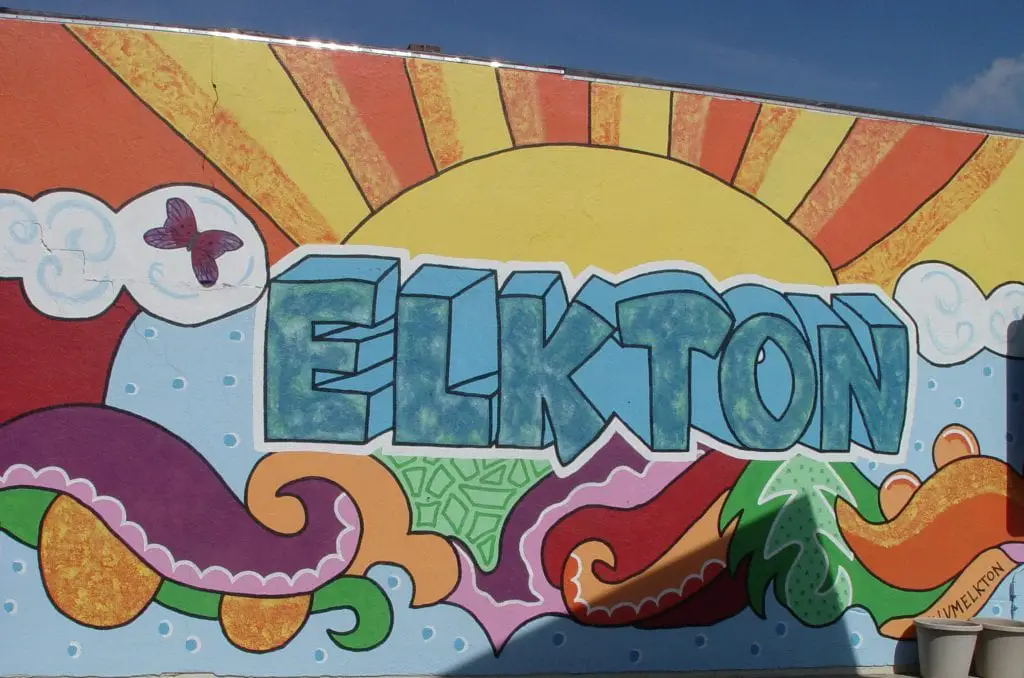
By the 1950s, Elkton remained a close-knit farming village of a few hundred people. Its Main Street shops, churches, and schoolhouse anchored life. In later decades, residents preserved this history: the Elkton Historical Society (Log Cabin Museum) now collects old tools, trophies, and antiques from the era. Annual events like the Elkton Autumn Festival Days (started in the mid-20th century) and today’s music-in-the-park celebrate the town’s heritage. Many century-old photos survive in postcards and archives, letting us glimpse Elkton’s dusty streets and lively community.
Though Elkton never grew large, its story is emblematic of Michigan’s small towns. It shows how railroads and agriculture built communities, how ordinary people met disasters like a school fire, and how local businesses and events knit together village life. The images above capture the feel of that bygone era, from horse-drawn wagons and early cars on Main Street to the towering grain elevators and the opera house.
Video – Michigan Moments Elkton Michigan
Sources
Historical newspaper archives and local histories provide this account. Key references include Thumbwind magazine and historical essays (for events like the 1930 school fire)
- Elkton was founded in the 1880s by a blacksmith named W.J. McGillivray, who reportedly named it after shooting an elk on his wife’s clothesline (Romig, Michigan Place Names).
- The Pere Marquette Railroad was the backbone of Elkton’s growth, turning the village into a shipping point for grains and livestock (Michigan Railroad Commission Annual Report, 1897–1915).
- A three-story hotel at the north end of town, operated by Henry Gosen, was financed by Banner Brewing of Saginaw and became a local landmark (Huron County Historical Society).
- Main Street businesses—including the Elkton Cash Store and Elkton Garage—flourished as the auto age took hold. Early storefronts and vehicles are visible in archival RPPC images.
- The Elkton school fire of December 14, 1930, destroyed the village’s red-brick schoolhouse, but the town rallied to rebuild it within a year (“The Fire That Shook a Town – Elkton’s 1930 School Blaze,” Thumbwind).
- Following the fire, classes were temporarily held in a local bar and church basement, and a new school was built with $60,000 in bond funding (Laker School District Archives).
- The Elkton Grain Company and later the Cooperative Elevator Co. were cornerstones of the town’s agricultural economy (Cooperative Elevator Co. History).
- Social events were held at the I.O.O.F. Hall and Opera House, which hosted concerts, meetings, and traveling vaudeville shows (Huron County Historical Society).
- Local news coverage of Elkton’s early years came from the Elkton Record, originally launched in 1883 as the Elkton Times under editor C.A. Bancroft (Michigan Digital Newspaper Project).
- The Sanborn Fire Insurance maps of 1909 and 1921 show the layout of Elkton’s commercial and residential areas at the time (Library of Congress Sanborn Maps).
- Kenneth Ginter’s “Elkton Electric” shop brought the first television to town, with locals gathering to watch prizefights and presidential addresses in the 1940s (Elkton Historical Society Archives).

